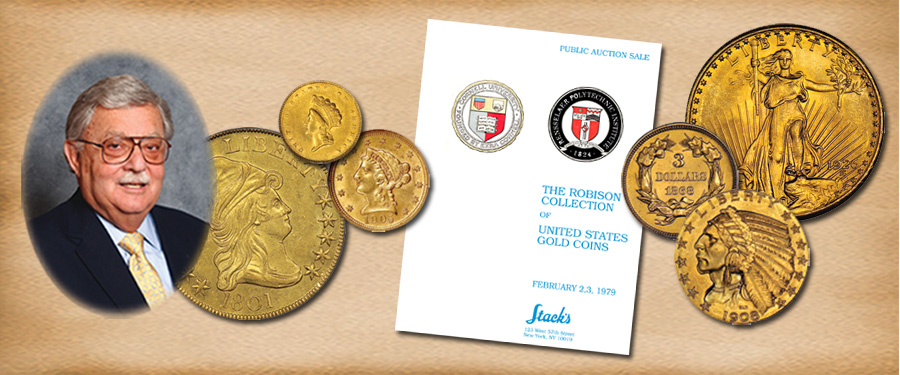
Some collectors collect for the pleasure of collecting and the pride of possession. Some collect to compete with other collections, either those of the past or those of their contemporaries.
After a collector completes his or her goal, they will often have their collections sold at auction (and have a catalog as a living remembrance of their endeavors) or they will sell the collection privately. Sometimes they leave it to a member of the family to continue enjoying and possibly enlarging, or give it to a charitable institution in which case it is usually sold for fund raising purposes.
The Robison Collection was sold in two parts. The U.S. gold coins were sold for the benefit of Cornell University and Rensselaer Polytechnic Institute. The Robisons were deeply involved with both institutions and had provided financial support to both even before 1979. Ellis Robison (called "Roby" by his friends) and his wife, Doris, had earlier donated a "Hall of Fame" to Cornell University to honor the school’s athletes, past and present. They had also contributed to many athletic programs including a sport and recreation center at Rensselaer. "Roby" had received Cornell University and Rensselaer Polytechnic institution’s highest honors. In addition, they provided to Cornell University and Union College herb gardens (used to develop and grow new drugs), which received international recognition. At Cornell the gardens are considered the most comprehensive and complete herb gardens in the United States.
It was to continue this support, that the Robisons sold their collection of U.S. gold coins through a Stack’s auction in January 1979. The collection was very comprehensive and almost complete. It included a complete set of gold dollars (lacking the 1849-C Open Wreath); the quarter eagle collection ($2.50 gold) began in 1796 and was virtually complete, including the early dates, and boasted an 1841 and a number of Proofs. The three dollar gold selection was complete but for an 1870-S, with many Mint State and Proof examples.
The half eagles ($5 gold) featured many dates, including the very rare coins of the series prior to 1834 and the eagles ($10 gold) were just about complete from 1795 to 1932, with many high-grade specimens. The double eagle collection ($20 gold) from 1849 to 1932 was virtually complete, and within the Saint-Gaudens series only the 1933 was missing. A great number were Mint State and Proof. The Robison Collection of U.S. Gold Coins did have a $4 "Stella," and a complete set of Panama Pacific coinage, a gold commemorative set of $1 and $2.50 pieces, and a Confederate cent struck in gold.
The auction of the Robison Collection of United States Gold Coins was very exciting, not only because of its near completeness but also because it offered many highlights pedigreed to famous collections. The next part of this fabulous collection, containing rare copper, nickel and silver coins of the United States, including many complete series, will be featured in part 2 of this article.





